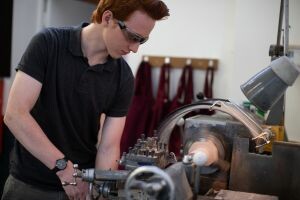Product Design
Contact Teacher: Mr J Bonney, Head of Design & Technology
Exam Board: AQA
Vision
In order to realise our vision, our curriculum will provide students with opportunities to: engage in hands on learning in well-resourced workshops, ICT suites and kitchens; view high level exemplar design and making which shows them what they are truly capable of; develop underlying knowledge of the theory that clearly relates to the practice taking place; see their teachers modelling best practice, whether designing or making; work alongside teachers who actively challenge and support them to achieve their potential; question the very idea of technological development using real world examples that encourage them to express their views and debate issues with passion; develop lifelong practical life skills that will enable them to cook, repair, design & make in their lives outside of Bishop Luffa School; engage in educational visits where they get to see the subject in real life, therefore leading to greater understanding and exposing them to the potential jobs, careers or further education opportunities available to them; develop the knowledge, understanding and skills that will enable them to pursue their dreams and ambitions beyond their Bishop Luffa School journey.
The impact of our curriculum will be evidenced in: our students’ enthusiasm for the subject which is displayed both in and out of the classroom;
- our students’ work and their progress as evidenced in their written and oral work;
-
the increased number of students taking D&T in KS4 and KS5;
-
the progress and attainment of students in external exams.
Above all, our students are aware that design and technology is integral to life in our modern world. They are keen to push the boundaries, try out new ideas, take a critical view and apply their skills in imaginative ways. They are able to see the bigger picture, viewing themselves as positive users of technology whilst also being critical of its possible impact on the world, both positive and negative.
Why study Product Design?

Product Design provides all students with the best natural link between knowledge and the application of science and mathematics in business and commerce. The coursework component of Product Design provides every student with the opportunity to develop key project management skills that they are able to transfer to any future career.
Product Design provides students with an opportunity to learn to use current technologies and consider the impact of future technological developments. They acquire skills that are yet unidentified and become equipped to perform in a constantly shifting workplace.
Product Design equips students to be creative, independent thinkers. Students combine practical and technological skills with creative thinking to design and make products and systems that meet human needs. They learn to think creatively and intervene to improve the quality of life.
This qualification encompasses two key factors - creativity and sustainability. Students will develop a range of transferable skills to enable them to respond with confidence to the demands of undergraduate study and the world of work.
Course details
A-level Design and Technology: Product Design requires students to engage in both practical and theoretical study. This specification requires students to cover design and technology skills and knowledge as set out below. These have been separated into:
Technical principles : How it's assessed
• Written exam: 2 hours and 30 minutes
• 120 marks
• 30% of A-level Questions Mixture of short answer and extended response.
Designing and making principles: How it's assessed
• Written exam: 1 hour and 30 minutes
• 80 marks
• 20% of A-level Questions Mixture of short answer and extended response questions. Section A: • Product Analysis: 30 marks • Up to 6 short answer questions based on visual stimulus of product(s). Section B: • Commercial manufacture: 50 marks. Mixture of short and extended response questions
Designing and making principles Non-exam assessment (NEA) : How it's assessed
• Substantial design and make project
• 100 marks
• 50% of A-level Evidence Written or digital design portfolio and photographic evidence of final prototype.
Entry requirements
Maths and Science skills, knowledge and understanding underpin the theory and practice of design and technology. These skills will be embedded within the examination of this qualification.
Grade 6 or above in GCSE D&T (not required if subject wasn't studied at GCSE). Grade 5 or above in GCSE Maths.
